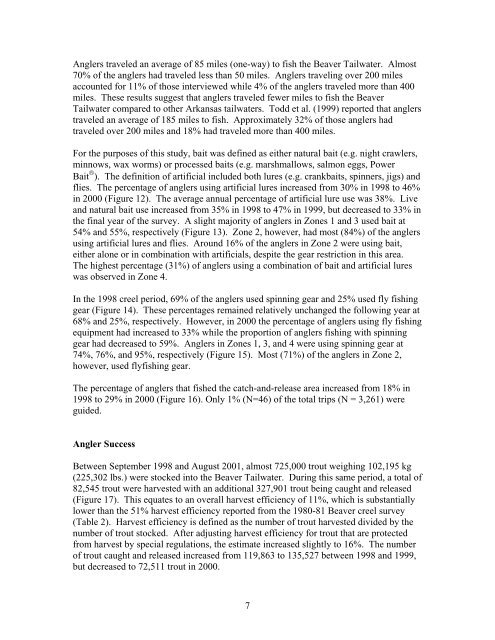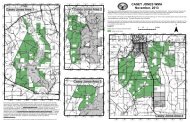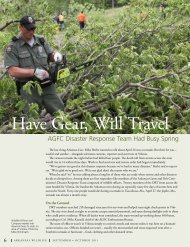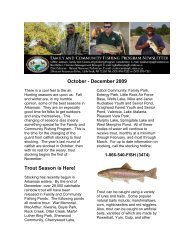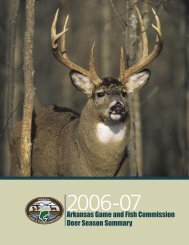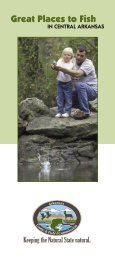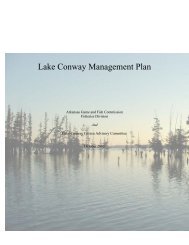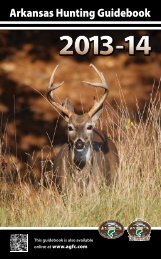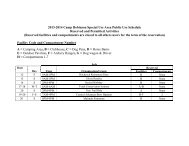Beaver Lake Tailwater | Creel Survey 1998-2000 - Arkansas Game ...
Beaver Lake Tailwater | Creel Survey 1998-2000 - Arkansas Game ...
Beaver Lake Tailwater | Creel Survey 1998-2000 - Arkansas Game ...
Create successful ePaper yourself
Turn your PDF publications into a flip-book with our unique Google optimized e-Paper software.
Anglers traveled an average of 85 miles (one-way) to fish the <strong>Beaver</strong> <strong>Tailwater</strong>. Almost70% of the anglers had traveled less than 50 miles. Anglers traveling over 200 milesaccounted for 11% of those interviewed while 4% of the anglers traveled more than 400miles. These results suggest that anglers traveled fewer miles to fish the <strong>Beaver</strong><strong>Tailwater</strong> compared to other <strong>Arkansas</strong> tailwaters. Todd et al. (1999) reported that anglerstraveled an average of 185 miles to fish. Approximately 32% of those anglers hadtraveled over 200 miles and 18% had traveled more than 400 miles.For the purposes of this study, bait was defined as either natural bait (e.g. night crawlers,minnows, wax worms) or processed baits (e.g. marshmallows, salmon eggs, PowerBait ® ). The definition of artificial included both lures (e.g. crankbaits, spinners, jigs) andflies. The percentage of anglers using artificial lures increased from 30% in <strong>1998</strong> to 46%in <strong>2000</strong> (Figure 12). The average annual percentage of artificial lure use was 38%. Liveand natural bait use increased from 35% in <strong>1998</strong> to 47% in 1999, but decreased to 33% inthe final year of the survey. A slight majority of anglers in Zones 1 and 3 used bait at54% and 55%, respectively (Figure 13). Zone 2, however, had most (84%) of the anglersusing artificial lures and flies. Around 16% of the anglers in Zone 2 were using bait,either alone or in combination with artificials, despite the gear restriction in this area.The highest percentage (31%) of anglers using a combination of bait and artificial lureswas observed in Zone 4.In the <strong>1998</strong> creel period, 69% of the anglers used spinning gear and 25% used fly fishinggear (Figure 14). These percentages remained relatively unchanged the following year at68% and 25%, respectively. However, in <strong>2000</strong> the percentage of anglers using fly fishingequipment had increased to 33% while the proportion of anglers fishing with spinninggear had decreased to 59%. Anglers in Zones 1, 3, and 4 were using spinning gear at74%, 76%, and 95%, respectively (Figure 15). Most (71%) of the anglers in Zone 2,however, used flyfishing gear.The percentage of anglers that fished the catch-and-release area increased from 18% in<strong>1998</strong> to 29% in <strong>2000</strong> (Figure 16). Only 1% (N=46) of the total trips (N = 3,261) wereguided.Angler SuccessBetween September <strong>1998</strong> and August 2001, almost 725,000 trout weighing 102,195 kg(225,302 lbs.) were stocked into the <strong>Beaver</strong> <strong>Tailwater</strong>. During this same period, a total of82,545 trout were harvested with an additional 327,901 trout being caught and released(Figure 17). This equates to an overall harvest efficiency of 11%, which is substantiallylower than the 51% harvest efficiency reported from the 1980-81 <strong>Beaver</strong> creel survey(Table 2). Harvest efficiency is defined as the number of trout harvested divided by thenumber of trout stocked. After adjusting harvest efficiency for trout that are protectedfrom harvest by special regulations, the estimate increased slightly to 16%. The numberof trout caught and released increased from 119,863 to 135,527 between <strong>1998</strong> and 1999,but decreased to 72,511 trout in <strong>2000</strong>.7


